With Wayward Lass in the Broken Group Islands
By Jamie
Orr
The Broken Group Islands, often
just called the Broken Islands, are tucked into Barkley Sound,
forming part of the Pacific Rim National Park on the west coast
of Vancouver Island. In 1985, we flew over these islands in a
light plane. Ever since then, I’ve wanted to visit them
by water – and this year my wife, son and I finally did
just that, in our Chebacco Wayward Lass.
Barkley
Sound
(click images to enlarge) |
Vancouver
Island:
the star shows Ucluelet |
|
|
The Broken Group is a very popular
destination for kayakers, offering beautiful scenery and fairly
short crossings between islands. However, the area also demands
some care -- the guide books warn of rough conditions in Loudoun
Channel to the north and Imperial Eagle Channel to the south of
the group, and speak of thick fogs that can roll in at any time
of year. We planned to cross both of these, launching at Ucluelet
to the north and visiting Bamfield to the south.
After a five hour drive from Victoria,
over progressively narrower and more winding roads, we arrived
in Ucluelet well after lunch. After a stop at the grocery store
for fresh milk, we headed for the launch ramp. By 3:00 pm we had
Wayward Lass rigged, loaded, and floating in the harbour, where
she was quickly joined by Alan’s Elegant Punt Creamsicle,
which served as our tender for this trip.
A nice sailing breeze was blowing
from the northwest, so as soon as we were clear of the docks we
turned into the wind and got the sails up, then headed south towards
the harbour mouth.
I read guidebooks a lot.
They’re a great help, but the authors must live in constant
fear of being sued when someone drowns him (or her) self, as they
seem to dwell overmuch on any potential dangers. Leaving Ucluelet,
I was fully prepared for strong winds, high seas and blinding
fog – all at once! I had the chart marked with the courses
to our first destination, I had waypoints in the GPS to back up
these, and I had the reefing lines and oilskins all ready to hand.
However… what we found outside the harbour was a blue sky,
a sea sparkling in the sun, and a ten or twelve knot following
wind. We promptly put away our worries and our oilskins, sat back
and enjoyed a perfect sail.
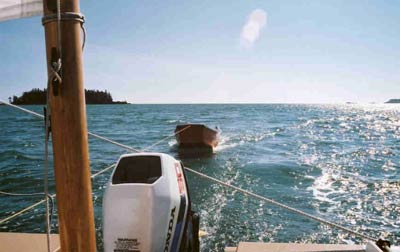 Here's Creamsicle dancing along behind
as we leave Ucluelet Harbour.Elegant punts tow very well!
Here's Creamsicle dancing along behind
as we leave Ucluelet Harbour.Elegant punts tow very well! |
I followed my carefully charted
course anyway, since it suited the wind, until we neared Dodd
Island, where turned aside to enter the anchorage by a narrow
channel between Dodd and Willis Islands. A nice looking power
cruiser (converted fishing boat?) was also checking out the channel,
but turned back and anchored in deeper water. Our chosen anchorage
was in a sort of lagoon formed by Dodd, Willis and Turtle Islands,
plus one or two smaller ones – the wind was dropping as
we entered, but we had just enough left to carry us to a small
cove where we anchored about 6:20.
We dropped the Danforth onto
a good mud bottom, then turned to setting up our cockpit tent.
Previously we’ve used a modified blue polytarp, slung over
the boom and fastened to the gunwales – dry but cramped.
This trip was the trial voyage for the just-finished Mark II Polytarp
Boom Tent – white polytarp this time, still slung over the
boom, but sewn from scratch from heavier material, and employing
spreaders to give us sitting headroom anywhere in the cockpit.
The forward end is filled in by two detachable pieces –
these will be refined in future, but they worked fine for this
trip. The back end is completely open, so we pulled a small tarp
over our legs at night to keep off the dew. At anchor, Wayward
Lass swings to face the wind so rain doesn’t blow in, but
I’ll probably add a back panel so we can stay dry when stationary
at a dock. For a first outing, the tent received very high marks.
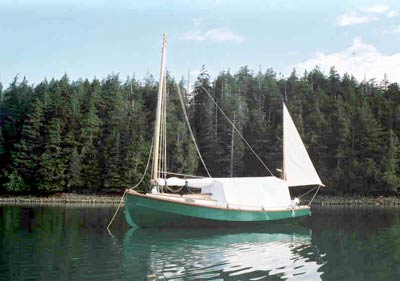
Wayward Lass at anchor in the
morning, showing the Mark II tent. That’s Dodd Island
in the background. |
After supper, we pulled ashore
in Creamsicle to investigate the campsite on Dodd. It was a nice
area, tucked in under the trees but it demonstrated the biggest
drawback for kayakers – in order to preserve the wilderness
state of these islands, camping is only allowed in designated
areas, so naturally these sites fill up every night. We counted
either 22, 23, or 24 kayaks on the shore, depending on who’s
count was right, and we were told that there were about 40 campers
there (some kayaks were doubles.) However, anyone who takes the
trouble to paddle out here is usually the “right”
sort of person, so people mostly get along well. Since we were
sleeping aboard, we were free to anchor off any island we liked,
but we faced a practical restriction as not all the islands offer
safe anchoring. In very bad weather, the kayakers would definitely
have the best of it, as they and their boats are safe ashore!
We had an undisturbed night. Maureen
occupied the cabin while Alan and I slept in the cockpit. (I’ve
described elsewhere how we use the floorboards to turn the whole
cockpit into a level sleeping platform.) Sleeping three takes
some coordination. Perhaps it was just as well that Lindsay, Alan’s
sister, couldn’t come along – she was busy with university
preparation and part time work. In the morning we had a leisurely
breakfast of pancakes and bacon, then lifted the anchor around
10 o’clock.
We raised the sails and ghosted
out the north entrance of the lagoon, past a dozen or so kayaks,
then turned south around the Tiny Group on our way to Effingham
Bay. The sky was overcast, but visibility was good. We had to
pay some attention to chart and compass due to the large number
of islets and rocks – it would have been easy to get confused.
I added a waypoint on the GPS as a check, but it wasn’t
necessary as all the bits and pieces fell into place as we made
our way to the south.
The wind was in the southwest,
and once we were away from the shelter of the islands forming
our anchorage, it was again in the 10 to 12 knot range (all wind
speeds given are only estimates). We had to make a couple of tacks
before we could hold a course that would let us into the bay,
which meant some additional chart work, adding more interest to
an already full morning. We entered Effingham Bay between two
islets that form a chain on the north side of the bay, then ran
east into the head of the bay, letting go the anchor in thirty
feet of water and stopping about one hundred feet from shore.
There were two bigger sailboats already at anchor, but they both
left as we approached – maybe we should have showered! In
any case, we had the whole place to ourselves, but for one big
power cruiser near the main entrance, about a quarter of a mile
away.
The forecast was for strong winds
in the afternoon, so we decided to have lunch and look around
before making any decisions about the rest of the day. There is
a trail to the east side of Effingham, and then just a bit to
the south there are some sea caves, including an arch through
one of the bluffs. We rowed ashore in Creamsicle to have a look
for these.
The trail is not marked, but we
had no trouble finding our way. It comes out right at the site
where there was a substantial Indian village in the last century.
There is a beautiful beach there, and the small bay is sheltered
from the northwest winds. No one lives there now, and there are
no signs, at least to the untrained eye, of any settlement ever
having existed. Since this is an Indian Reserve, we were technically
trespassing, but since we weren’t camping or lighting any
fires, we thought it should be okay.
We hiked south as far as we could,
but the almost high tide finally stopped us at a deep cleft in
the shore. We didn’t try hiking around it due to the steep
bluffs and the thick salal bushes that grow close to the ocean
on this coast. We found out the next day that we were only a few
yards short of the arch, but it might as well have been miles.
We retraced our steps to the beach, where we cooled off by wading
in the crystal clear water.
Alan and Maureen swore that
while we were there, they saw a sea monster named Frank, but I
was, and still remain, skeptical.
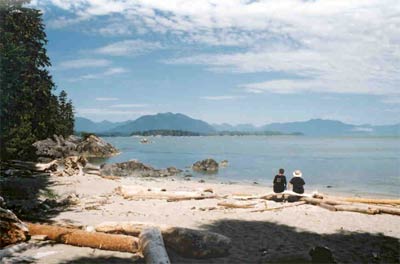 Alan and Maureen on the beach, looking
northeast towards Gibralter Island. The high mountains in
the background are on Vancouver Island. (Frank eluded the
photographer….)
Alan and Maureen on the beach, looking
northeast towards Gibralter Island. The high mountains in
the background are on Vancouver Island. (Frank eluded the
photographer….) |
Once back at the boat, we found
the wind had indeed risen, and we decided to stay in Effingham
Bay for the night. However, we didn’t want to sit and do
nothing, so we picked up our anchor and motored over to Gilbert
Island just outside the bay, about half a mile away. This is another
of the designated campsites, again equipped with a small beach
and good shelter from the wind, under the trees. It was only mid-afternoon,
and most of the campers were still out paddling, but we chatted
with one elderly kayaker who told us he and his wife come here
every year, setting up their base camp on Gilbert and making day
trips to the surrounding islands. The outermost islands are not
far from Gilbert Island, and offer some great paddling for experienced
kayakers. There are a lot of sea lions on the outer islands, and
we could hear them from the campsite.
After exploring the island, we
motored back to the head of our bay, where we took some care in
setting the anchor for the night (this is another way of saying
it took me three tries to get it right). Effingham Bay is sheltered
from big waves and swell, but still somewhat open to the northwest
wind, and there was a small chop making some noise at our bow.
I cut a square of spare tent material, and added grommets to the
corners in hopes of making a crude nose bra to muffle the noise,
but it wasn’t a great success. Some more tailoring, along
with some weight at the after edge might fix it, but I haven’t
pursued the idea so far. We slept well in any case.
Next morning was overcast, with
low clouds all around us, but dead calm. I was awake early, so
went for a row in Creamsicle while the others had their sleep
out. As I rowed towards the mouth of the bay, I could see that
we now had three neighbours, all powerboats. I also saw a large
animal splashing around, either a big sea lion or a small whale.
A good view of its tail as it dove settled the matter in favour
of a sea lion – although a whale would have been more exotic!
I carried on to Gilbert Island, where there were now a dozen or
more kayaks pulled up on the beach. Walking across to the other
side of the island, I saw (and heard) another sea lion finding
his breakfast, then stopped on my way back to talk some more with
the same couple, who were loading up their kayak to return to
civilization.
Back at Wayward Lass, the rest
of the crew was stirring, and it wasn’t too long before
we’d had breakfast and were ready to push on. The morning
was virtually windless, so we woke up Honda again. At the narrow
passage between Effingham and Gilbert we had to pause so as not
to run over eight or ten kayaks headed for the Gilbert campsite,
then once through the pass we headed south. We were on our way
to visit Wouwer Island, at the outer edge of the group, but wanted
to avoid a large patch of water densely filled with reefs and
rocks, so we detoured for a look at Dicebox Island on our way.
There is a narrow pass leading
into the semi-sheltered basin between Wouwer and its neighbor,
Batley Island – our chart showed a reef extending from one
side, but didn’t make it clear that this ended with a big
rock in the middle of the pass! We saw it in time to avoid hitting
it, but only just. The water didn’t look particularly deep
on the other side either, so we were glad of our shallow draft.
The basin, with its rocks
and islets, was full of sea lions. They covered much of the rocky
shores, and kept up a constant din, challenging us and each other
to come any closer. We circled the biggest islet twice, taking
in the sights. We struck a sadder note when we noticed one animal
off by itself on the shore, with a six or eight inch fishing lure
hanging from its mouth. We didn’t know if the flasher would
tear loose, or if the hook would eventually cause the sea lion
to starve, but it took some of the enjoyment out of our morning
to see this.
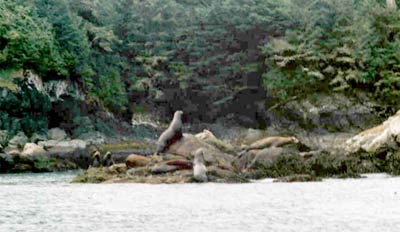 Sea lions at Wouwer Isand. I wish
we could print the sound effects, they were giving it all
they had!
Sea lions at Wouwer Isand. I wish
we could print the sound effects, they were giving it all
they had! |
We exited past our rock, on the
other side this time, then paused to think about anchoring in
the basin and watching the sea lion for a longer time. However,
we decided against this when we saw fog approaching from the open
sea. Instead, we retraced our route to Gilbert Island –
we seem to have spent a lot of time there, but it just happened
to be on a cross-roads of our routes that morning.
The fog didn’t develop into
anything serious, so we carried on south and east around Effingham
to look for the arch we couldn’t find the day before. We
found it easily this time, but didn’t try to land as the
shore was all rocks and breakers. The arch is just north of Meares
Bluff, the most easterly point of Effingham – to the southeast
was Imperial Eagle Channel, the Deer Group Islands, and Bamfield,
a small community on Vancouver Island itself. We had a one to
two meter swell from the southwest, with a very light wind from
the same direction, the fog appeared to have gone away, and the
Deer Group was visible, if not very clearly – all in all
it looked like a good time to visit Bamfield. A quick look at
the chart gave us our course to Satellite Passage (between two
of the Deer Group) about four miles away, and off we went. The
wind was too light to sail effectively, so we carried on motoring.
Just over an hour later we were
in Bamfield Inlet, looking for somewhere to tie up. The west side
of the Inlet does not have road access to the outside world, and
is served by a wooden boardwalk that follows the waterfront. All
the docks were full on this side, and I didn’t want to go
alongside another boat if I could avoid it. The village on the
east side of the inlet isn’t a whole lot bigger, but it
has a store, a pub and a few other amenities, including paved
roads that will take you out to the rest of the world. It also
has the largest of the three public docks in Bamfield. Before
we got that far, however, as I was putt-putting slowly past another
dock to read the sign on it, something made me look over my shoulder.
Gliding along right on our tail was the coastal freighter Lady
Rose! I did a quick 360 to port to let her go by, then crossed
her stern as she stopped at the next dock. She gave me a shock,
but on reflection, I guess she was just being a good maritime
citizen, waiting quietly for us to get out of her way.
There was a strong smell of oil
in the air from an old tug that had mostly sunk at her moorings
only a few days before. There was a containment boom around her,
but not much else happening about it while we were there. However,
the smell didn’t bother us much, as we’d promised
ourselves a Bed and Breakfast for the night. We wanted flush toilets,
showers, real beds – and someone else to cook breakfast!
Marie Ostrom at Marie’s Bed
and Breakfast delivered everything we hoped for, for a very reasonable
price. We even had our own TV with a huge choice of movies to
watch. Bamfield is the end of the road for the West Coast Trail,
a week-long hike from Port Renfrew away down the coast. This was
originally built as a life-saving trail – this stretch of
the coast is known as the Graveyard of the Pacific. Since the
trail was re-opened by the Boy Scouts in the 60’s, it has
become an extremely popular trek, so much so that reservations
are now required, and a lottery system is used to assign these
in the busy months. In Marie’s other guest room were three
hikers just off the trail. They also appreciated the food –
Marie told us that because so many of her B&B guests are backpackers
who have been out for a week or more, she never serves oatmeal
at breakfast!
Back in Wayward Lass, we crossed
to the west side again, finding space easily now that all the
fisherfolk were out on the water. We strolled the length of the
boardwalk, stopping for coffee (or whatever – I’m
the only coffee drinker in the crew) at the Boardwalk Bistro.
Leaving Bamfield, there was
a light north-west wind so we set course under sail for Robbers
Passage, another pass through the line of islands making up the
Deer Group. After tacking once or twice, we reached it to find
the wind dead against us inside the passage. Although a slight
current was also running against us, the wind was at least steady,
so we were able to short-tack our way through. The passage is
narrow at either end, but there is quite a large bay in the middle.
On the south shore of this bay is an outstation belonging to the
Port Alberni Yacht Club (Port Alberni is about 25 miles away,
up the narrow Alberni Inlet). On the north shore is the Sea Shepherd,
Greenpeace’s old ship, now rusting away and generally spoiling
the view.
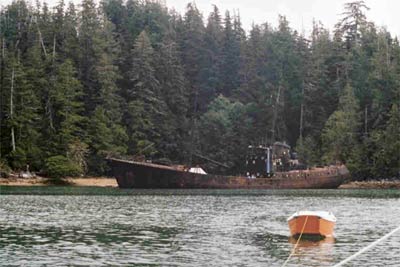 The Sea Shepherd, parked in Robbers
Passage.We weren’t sure if she is fully afloat, but
she looks to be on an even keel, so maybe she is.
The Sea Shepherd, parked in Robbers
Passage.We weren’t sure if she is fully afloat, but
she looks to be on an even keel, so maybe she is. |
The wide bay was helpful in that
it let us line up nicely for the narrow dog-leg at the other end.
I enjoyed working our way through both ends of Robbers Passage
– open water sailing is all right, but manoeuvring around
and through tight places is even more fun. Once out, we turned
towards Marble Cove, to admire the sea arch and caves there. The
crew wanted a closer look, so we sailed in and anchored off to
a shingle beach at the head of the bay. The wind, by now a healthy
breeze, was blowing straight into the bay, but I wasn’t
too worried about the anchor, since the scope could only improve
with every yard the anchor might drag up the shelving bottom.
We rowed ashore in Creamsicle –
three of us was probably close to the maximum load it could handle
and still land without giving us wet butts. We didn’t have
surf, but the waves still required some concentration and timing
to touch and jump out before the next wave came aboard. We managed
this successfully, hauled the dinghy up the beach, then tied off
the painter to a log as well – belt and braces perhaps,
but I’ve seen canoes flipped around in the wind, and didn’t
want to swim home to Wayward Lass!
We had a good time exploring
the caves, one was quite deep, but we couldn’t get a good
picture of this, as there wasn’t enough light. But by a
happy coincidence, we were able to frame Wayward Lass in the cave
mouth, looking out.
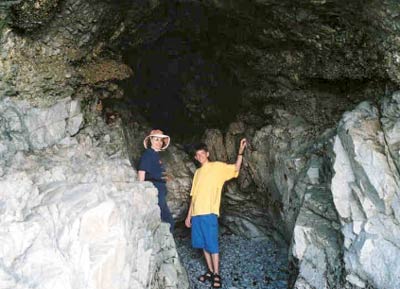
Maureen and Alan inside the cave
– it goes back further, but there wasn’t enough
light to show it.
|
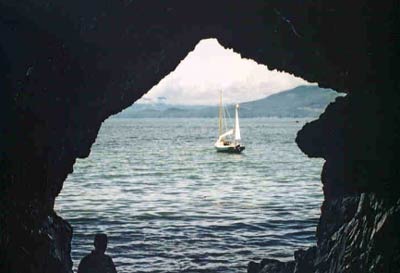 Alan crawled well back into the cave
to take this shot of Wayward Lass and myself.
Alan crawled well back into the cave
to take this shot of Wayward Lass and myself.
|
We couldn’t get to
the arch without climbing up some cliffs, or doing some serious
wading, so we re-launched Creamsicle, still managing to keep dry,
and rowed over. Alan got out on the rocks, but Maureen and I stayed
in the dinghy – we didn’t want to push our luck.
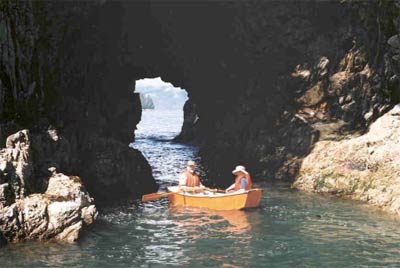 Here’s Maureen, and myself just
inside the arch. We had to wiggle past a narrow bit to get
this far, and didn’t try to go through as there wasn’t
room for the oars. Also, there was a good sized surge from
the wave action outside.
Here’s Maureen, and myself just
inside the arch. We had to wiggle past a narrow bit to get
this far, and didn’t try to go through as there wasn’t
room for the oars. Also, there was a good sized surge from
the wave action outside.
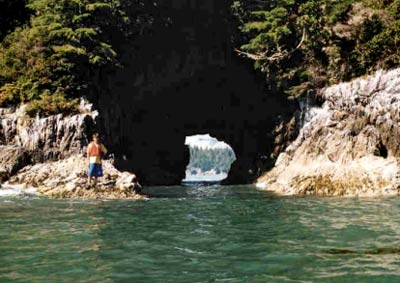 And here’s Alan wondering
when we’re coming back for him!
And here’s Alan wondering
when we’re coming back for him! |
|
Back at Wayward Lass again, we
decided we would sail out without using the motor. The wind was
still blowing into the cove, and we were only about 100 feet from
the beach, with perhaps slightly less room to either side because
of the rocks. We hoisted both sails, but left the mizzen sheets
loose so that we didn’t have to fool with them. The boat
started to sail as soon as the main was sheeted in, so Alan took
the helm and I pulled in the anchor as fast as I could, while
Wayward Lass sailed towards it. The anchor came free without trouble,
and I had it aboard before we had to tack again.
We sailed along the shore for a
while, then turned her head back towards the Broken Group. We
got a bit a shock then -- a bank of thick white fog was rolling
in. We immediately turned back for Robbers Passage, but this was
now to windward. It looked like the fog was going to beat us when
we had to put in an extra tack to clear some outlying rocks, but
we reached the entrance just before it. The fog didn’t follow
us inside, so we made for the outstation under a sunny sky. With
a gentle wind in the passage, parallel to the floats, we were
able to glide right into the dock.
The yacht club folks told us that
they almost never had fog, and I believe this as the channels
on both sides of the island were thick with it, while in the passage
between them there was bright sunshine! We stayed for an hour
or so, speaking to the yacht club hosts, then taking a short walk
up the “Crow’s Nest trail” and over to the other
side of the island. By the time we finished, the fog outside had
thinned and the Broken Group was visible again, so we set off
once more.
The wind was stronger now, and
the forecast said it would get stronger yet. Since it was also
dead against us, so we decided to take it easy and motor across
the four miles of Imperial Eagle Channel. The sun was out, but
the headwind and occasional spray made this a chilly crossing,
and we were glad to reach the shelter of Gibralter Island. Another
mile or so and we could turn into the shallow lagoon formed by
Jacques and Jarvis Islands, where we anchored for the night. There
was almost no wind inside, so we soon warmed up again. We explored
in Creamsicle, and found a drying “passage” between
the islands where they meet at the south side – I thought
we could take Wayward Lass out through here at high tide, however,
high tide was very early next morning, and no one wanted to get
up to try it. Probably just as well, if we’d stuck there
it might have been a while before we got out, not to mention scraping
the hull when we stranded on the sharp rocks!
This morning was our last of our
holiday. We picked a roundabout route back to Ucluelet past some
more of the outer islands, in hopes of seeing a whale –
grey whales sometimes stay all summer on this coast. There was
no wind, so we fired up Honda again and set off through the islands
to Clarke and Benson Islands.
Clarke is another campground island.
There is no safe anchorage here, but the sea was quiet so we had
no qualms about stopping for a while. We had a choice of anchoring
outside the kelp in deeper water or trying to find room inside,
beside a tiny beach. The third option was to put Wayward Lass
on the beach, but the tide was dropping and I didn’t favour
this idea. However there was just enough room inside the kelp
for one small boat on a very short scope, very near the beach.
We stretched our legs ashore and swapped stories with some of
the campers – one group were travelling by canoe and inflatable
rather than kayaks, with motors on both.
After a very short row back
to Wayward Lass, we hauled up the anchor and circled south to
go around the outside of the island. This put us in the open Pacific,
and was about our last chance to see a whale – but they
weren’t cooperating today, so that was that. Once we were
on the far side of the island, and clear of all rocks and islets,
we set course for Ucluelet. This meant crossing three or four
miles of mostly open water. As noted, the weather was calm, but
there was enough fog that we couldn’t see the other side
– in fact visibility was probably a quarter of a mile at
most. But we had our chart, compass and GPS, and Vancouver Island
is a pretty big target, so we weren’t worried. Our half-way
marker, the Alley Rock appeared out of the mist more or less on
time, and shortly after the fog lifted, leaving us to make the
rest of our way up Ucluelet Harbour in bright sunshine. On our
way in, we passed the Pacific Swift, a topsail schooner, and Pacific
Grace, a recently built Grand Banks schooner, both owned by Sail
and Life Training Society (SALTS) in Victoria.
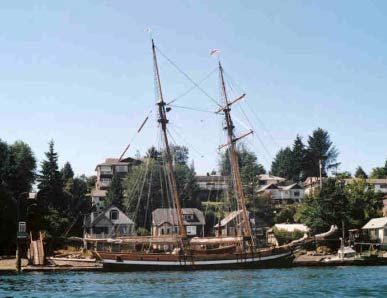 The Pacific Swift in Ucluelet Harbour
The Pacific Swift in Ucluelet Harbour
|
Once back at the marina, I fetched
the van and trailer, and backed down the ramp. There was no dock
beside the ramp, and not much room on the approach between the
floats and the breakwater, so I stood by the trailer while Alan
brought Wayward Lass in under motor. Throwing it out of gear at
the last minute, he hit the centre bunk dead on. I took up the
slack with the winch, and our Broken Islands cruise was over.
We’ll be back.
Barkley
Sound
(click images to enlarge) |
Vancouver
Island:
the star shows Ucluelet |
|
|

|

